I met with Mark Swoboda, the recently installed CEO of LED phosphor firm Intematix at their U.S. headquarters in Fremont, California. Intematix, which develops and manufactures phosphors for high-brightness LEDs, placed the veteran as CEO after his decade of leading sales and marketing teams at Philips Lumileds, and his three-year stint as CEO of LED start-up Bridgelux.
A century ago, the incandescent bulb replaced gas lamps and changed the world. Productivity and quality of life in the West underwent an enormous shift because of the Edison light bulb. Unfortunately, that invention was almost as effective as a heater as it was a light source -- and now in a carbon-constrained world, the LED light is finally poised to replace the inefficient incandescent.
According to a February 2010 DOE report, the projected energy savings from 2010-2030 as a result of LED lighting systems is estimated to total 1,488 terawatt-hours, representing $120 billion at today's energy prices. With the widespread adoption of LEDs into general lighting applications, these savings would reduce greenhouse gas emissions by 246 million metric tons of carbon.
After years of promise, LEDs are now the fastest growing segment in the $100 billion lighting industry, projected to reach $8.2 billion in 2010 and $20.2 billion by 2014 according to the Intematix website. LEDs offer a long life of 50,000 hours (compared to 1,000 hours for incandescent lights), significant energy savings and safety (LEDs are low voltage, cool to touch, and do not contain mercury) and durability.
A key challenge with LEDs has been the development of the phosphors that provide high quality white light.
And phosphors are Intematix's business.
Although LEDs consume nearly one-tenth the power of incandescent bulbs and half the power of compact fluorescents, they often have other issues. Some white light LEDs give off a greenish tone. The light from the chip is actually blue; the green tone appears because the yellow phosphor is not perfectly matched.
"It has to be high quality light," said Swoboda. When it comes to white LEDs for general lighting, "The number-one issue for specifiers and architects is the quality of light." He added, "CFLs don't do well in the U.S. because of the quality of light." And it's the phosphor's job -- Intematix's phosphor, that is --to deliver that light quality.
Notice that cost and efficiency are not always the first item of concern on the architect's list.
Intematix customers include the big LED vendors as well as TV manufacturers. They are looking at other markets like signage where phosphors make signs glow like neon with lower energy usage. The firm also sells lighting assemblies and luminaires, but more as technology demonstrators -- their core business remains phosphors. In the CEO's words, "The DNA of the company is all about phosphor materials."
Intematix has taken VC funding in the past (from DFJ, Crosslink and East Gate), but more recent funding has come from strategics including Samsung and Sumitomo.
Alan Salzman of VantagePoint Venture Partners sees a transformation occurring in lighting, with everything switching out to solid-state lighting and causing "a $100 billion industry to flip." He suggested that it would be cheaper for a utility to give away solid-state light bulbs than to build out another gigawatt of capacity.
In Salzman's view, the mammoth lighting incumbents like Philips, GE and Osram "might catch up -- or might not."
And in CEO Swoboda's view of the LED industry, "We see a watershed of bulb-type products coming into the market in the the next 12 to 15 months." He added, "We'll see 60 watt-equivalent bulbs with warm color temperatures" and "price points under $20, $15 and $10."
We're finally witnessing the efficiency transformation of the $100 billion lighting industry.



